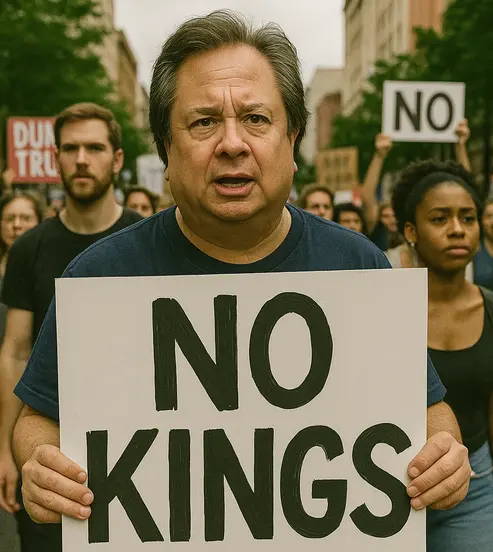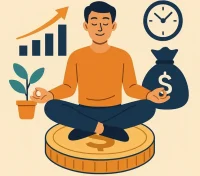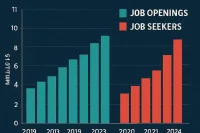George Conway TROLLS Trump at ‘No Kings’ protests as millions of Americans took to the streets with one simple message for President Trump: “You are not a king.” The massive demonstrations, held in more than 2,500 cities and towns across the country, drew nearly 7 million people—2 million more than the previous ‘No Kings’ protests held in June.
Conway, a prominent conservative attorney and co-founder of the Society for the Rule of Law, made headlines by wearing a provocative “I Am Antifa” t-shirt while marching with his corgi, Clyde, in Arlington, Virginia. The move was clearly designed to troll Trump and his supporters, who frequently demonize anti-fascist activists.
The protests come as Trump escalates what experts warn is his authoritarian reach, targeting cities, people, and institutions that oppose him. The demonstrations represent a growing resistance movement against what many see as an assault on American democracy.
The massive scale of the protests
According to No Kings Media, the protests were unprecedented in scope:
- 7 million participants across the country
- 2,500+ cities and towns involved
- 2 million more people than the June protests
- Peaceful, celebratory atmosphere nationwide
The demonstrations spanned from major metropolitan areas like New York City and Los Angeles to smaller towns in traditionally conservative states like Alabama and Idaho, showing the broad-based nature of the resistance movement.
George Conway’s calculated trolling
Conway, who has been a vocal critic of Trump despite being married to former Trump advisor Kellyanne Conway, made several calculated moves to troll the president:
The “I Am Antifa” t-shirt
Conway wore a t-shirt emblazoned with “I Am Antifa” while marching with his corgi, Clyde. The move was clearly designed to provoke Trump supporters who frequently use “Antifa” as a boogeyman to demonize protesters.
When asked about the shirt, Conway dismissed it as “completely silly” and noted that a Daily Caller photographer had taken a photo that was being used as a “gotcha” moment in conservative media.
The camera bag “bribe”
Conway also jokingly showed off what appeared to be a camera bag, quipping about “Mr. Soros” providing “walking around money”—a reference to conservative conspiracy theories about George Soros funding protests.
“I had all this walking around money thanks to Mr. Soros,” Conway joked on live television, clearly mocking the right-wing narrative about protest funding.
The Trump puppet interaction
Conway also interacted with a giant puppet of Donald Trump with an orange face and small hands, making a “peace offering” with the camera bag—another clear dig at the president’s physical characteristics that Trump is known to be sensitive about.
The atmosphere on the ground
Despite the serious nature of the protests, the atmosphere was described as “jubilant, peaceful, and celebratory” across the country.
Los Angeles: A party atmosphere
In Los Angeles, MSNBC correspondent Jacob Soboroff described the scene as “electric” with people “partying” and celebrating. The protests featured:
- Inflatable suits and costumes
- Creative signs like “The Only Orange Monarch I Want Is The Butterfly”
- A diverse crowd of teachers, workers, and community members
- No violence or clashes despite the large crowds
New York City: Diverse resistance
In New York City, protesters included both Democrats and former Republicans who no longer identify as MAGA supporters. The crowd was united by a sense of urgency and fear that the window to fight back against authoritarianism is closing.
What protesters are saying
The protesters had a clear message: they’re fighting for the promise of what America can be, not against America itself.
Core messages from the streets:
- “We’re still fighting for the promise of what this nation can be”
- “They are fighting to turn back the hands of time to bring us to darker times”
- “We are out here to stand up for this democracy”
- “The military is used for the defense of this country. It is not used to control the citizenry”
- “Do not cower to the fascism and the threats that are coming from DC”
Shape Your Future in Uncertain Times
With political and social movements reshaping America, job security and opportunity have never been more important. Take control of your career path by exploring opportunities on WhatJobs—your next step toward stability and growth.
Search Jobs Today →Personal stories from protesters:
Allison, a kindergarten teacher: “I’m CTA, I’m a teacher, I teach kindergartners, and we’re here to make it right for students and families in our community.”
Rosa, a veteran of Cesar Chavez protests: “I’m emotional. I went from Cesar Chavez fighting for the rights of the workers to being out here in Imperial Valley, Salinas, you name it.”
Angela, a first-time protester: “What doesn’t bring me out? I mean, everything that’s going on in this country is horrible. Taking away our rights, taking away our neighbors, kids being scared to go to school. It’s horrible.”
The urgency of the moment
Many protesters expressed a sense of urgency, fearing that the window to fight back against authoritarianism is closing rapidly.
Why the urgency?
- Trump’s escalating attacks on democratic institutions
- The pace and success of Trump’s efforts to target his enemies
- Recent ICE operations and other authoritarian measures
- Fear that resistance will become impossible if action isn’t taken now
George Conway’s assessment
Conway, speaking from his legal expertise, acknowledged both the urgency and the hope of the moment:
“If people weren’t getting together and doing this at this moment, we would be in big trouble. Because if what has been going on for the past few months and is accelerating isn’t enough to trigger a backlash of people saying, ‘This is not what we voted for. This is not consistent with our Constitution, with our laws, with our traditions, and with principles of honor and decency.’ If they weren’t standing up now, then we would be done. We would be done, and that window would close.”
The broader resistance movement
The protests represent more than just opposition to Trump—they’re about defending democratic principles and the rule of law.
What unites the protesters:
- Opposition to authoritarianism and fascism
- Defense of democratic self-governance
- Protection of constitutional rights and freedoms
- Resistance to the concentration of power in the hands of a few
- Commitment to the principle that no one is above the law
The diversity of the movement:
Despite being heavily Democratic in major cities, the protests drew participants from across the political spectrum, including:
- Former Republicans who no longer identify as MAGA
- Independents and moderates
- People from traditionally conservative areas
- Individuals from all walks of life and backgrounds
The legal and constitutional context
As an attorney and constitutional expert, Conway emphasized the legal basis for the resistance:
Constitutional principles at stake:
- Separation of powers
- Checks and balances
- Rule of law
- Democratic self-governance
- Protection of individual rights and freedoms
Why the courts won’t save us:
Conway warned that relying solely on the courts to protect democracy is insufficient:
“The courts aren’t going to save us. Nobody else is going to save us. We have to do something because the courts aren’t going to save us.”
The marathon, not a sprint
Conway emphasized that this is just the beginning of a long-term resistance movement:
Why it’s a marathon:
- Trumpism won’t disappear overnight
- Authoritarian tendencies are deeply embedded
- Systemic change requires sustained effort
- Democracy must be actively defended
The path forward:
- Continue organizing and mobilizing
- Build broader coalitions
- Engage in sustained political action
- Protect democratic institutions
- Educate others about the threats to democracy
The significance of the moment
The ‘No Kings’ protests represent a watershed moment in American resistance to authoritarianism. The massive turnout and peaceful nature of the demonstrations show that millions of Americans are willing to stand up for democracy.
What this means:
- Democracy is not dead in America
- Millions of citizens are engaged and active
- The resistance movement is growing and diversifying
- People are willing to take action to protect their rights
- The window for resistance remains open
The role of figures like George Conway:
Conway’s participation, complete with his calculated trolling of Trump, shows that the resistance includes prominent conservatives who are willing to put country over party. His legal expertise and constitutional knowledge add credibility to the movement’s claims about threats to democracy.
FAQs
Q: Why did George Conway wear an “I Am Antifa” shirt?
A: Conway was clearly trolling Trump and his supporters, who frequently demonize anti-fascist activists. The move was calculated to provoke and mock the right-wing narrative about protesters.
Q: How many people actually attended the protests?
A: According to No Kings Media, nearly 7 million people participated across more than 2,500 cities and towns nationwide—2 million more than the previous protests in June.
Q: Were the protests violent?
A: No, the protests were described as “jubilant, peaceful, and celebratory” across the country. There were no reports of violence or clashes despite the massive crowds.
Q: What was the main message of the protests?
A: The core message was “You are not a king” directed at President Trump, along with calls to defend democracy, resist authoritarianism, and protect constitutional rights.
Live example — user point of view
I was at the ‘No Kings’ protest in my city, and I have to say, George Conway’s trolling was absolutely brilliant. When I saw him on the news wearing that “I Am Antifa” shirt while walking his corgi, I couldn’t help but laugh. It was such a perfect way to mock Trump and his supporters who are always going on about “Antifa” being some kind of boogeyman.
The atmosphere at our protest was incredible. It wasn’t angry or violent at all—it was actually really joyful and celebratory. People were dressed up in costumes, carrying creative signs, and there was this sense of community and solidarity that I haven’t felt in a long time.
What struck me most was the diversity of the crowd. It wasn’t just the usual suspects—there were teachers, nurses, small business owners, and even some people who said they used to be Republicans but can’t support Trump anymore. Everyone was united by this sense that something is very wrong with our democracy right now.
I think Conway’s right that this is just the beginning. We can’t just show up once and expect everything to be fixed. This is going to be a long fight to protect our democracy, and we need to keep showing up, keep organizing, and keep making our voices heard.
The urgency is real, though. Every day it feels like Trump is doing something else to undermine our institutions and concentrate power in his own hands. If we don’t fight back now, while we still can, we might lose our democracy entirely.




